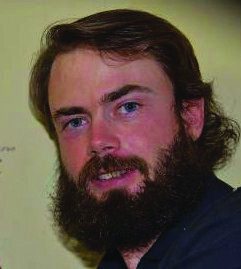Throwing a baseball like a Jedi
Posted on May 5, 2016 by Maple Creek
Here and There – by Dominique Liboiron
The Major League Baseball season is underway and Canada’s team is lagging in the standings.
Despite their lacklustre start, the Toronto Blue Jays still have a lot of time to turn the season around. One of the pitchers I enjoy watching the most is the Jays’ R.A. Dickey.
He’s a rarity. Dickey is one of the only pitchers currently in the majors who throws a knuckleball. In most cases, a pitcher spins the baseball to make it curve, dip or raise. Dickey has a different approach, “You’re doing the opposite,” he explained in a radio interview. “You’re taking the spin off the ball.” When thrown properly, a knuckleball only rotates a quarter of a turn between the release and the catcher’s glove.
Because the ball doesn’t spin, it pushes against the air and follows an unknowable route to the plate. It weaves, it bobs, it sinks. No two pitches are alike. Air density, temperature and humidity all affect the ball’s path. Dickey admits he can’t pinpoint where the pitch will go, but his aiming point is two baseballs above the catcher’s helmet. Once the ball leaves his hand, it’s subject to many variables.
That’s why the knuckleball is so hard to hit. The batter can’t predict where it will go. It’s also thrown more slowly and this upsets the timing of hitters who are used to most pitches thrown between 90 and 95 mph. On average, a knuckleball travels at 75 mph.
The knuckler is also easy on a pitcher’s arm, “You only have to throw at 75 to 80 per cent capacity so you can pitch later in life.” Dickey said prime-time for members of his “secret society” is between 38 and 44 years of age, much older than fastballers. Dickey is 41.
Dickey digs his fingernails below the ball’s horseshoe-shaped seams and keeps his wrist stiff. Beyond that, he says a well-thrown pitch just feels right as it leaves his hand. He can tell immediately if the throw will be successful or not.
He has other pitches he falls back on such as the curve ball, sinker, cutter and change-up. The Nashville-born hurler uses these when he struggles with his knuckleball, but the knuckler still accounts for about 85 per cent of his throws.
He said he learned his craft by studying other pitchers who rely on this elusive toss, men such as Tim Wakefield, Charlie Hough and Phil Niekro. Dickey was tutored by Hough. Dickey has likened the group to a band of Jedi Knights.
The other part of this knuckleballer’s success is playing with a catcher who has the ability and patience to work with Dickey, something he says he has been blessed with.
While winning a Cy Young Award is a noteworthy achievement, one few pitchers experience, there is so much more to Dickey than his baseball prowess. He’s also an interesting person with a captivating story.
In many regards, this Toronto Blue Jay is as unique as his signature pitch. For starters, he holds an English Literature degree which means his interviews aren’t just a repetition of sports clichés and platitudes that we hear so often from professional athletes. He has insightful opinions he expresses well. Dickey is also an author and he won an Olympic bronze medalist for baseball at the Atlanta Games.
He was drafted by the Texas Rangers in the first round, 18th overall, but then almost didn’t make the majors when it was discovered he was born without a ligament in his elbow that would normally mean he couldn’t pitch. Many in baseball wrote him off. Dickey is a testament to what you can do if you work hard and believe in yourself.
Although his pitching so far this season hasn’t been impressive, the Jays have struggled as a team. Nevertheless, Dickey has the talent and experience to help guide Toronto back into the postseason.


Leave a Reply
You must be logged in to post a comment.